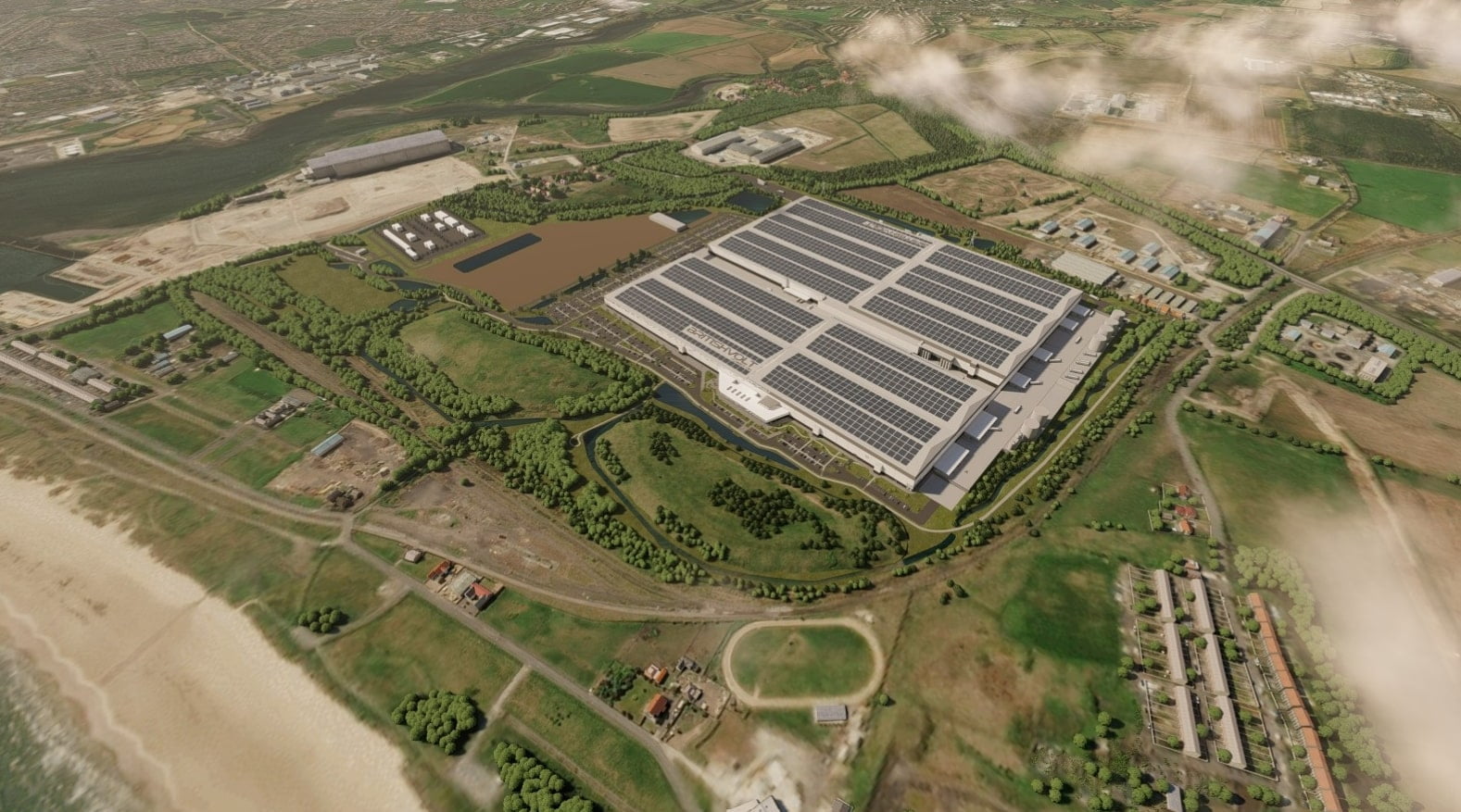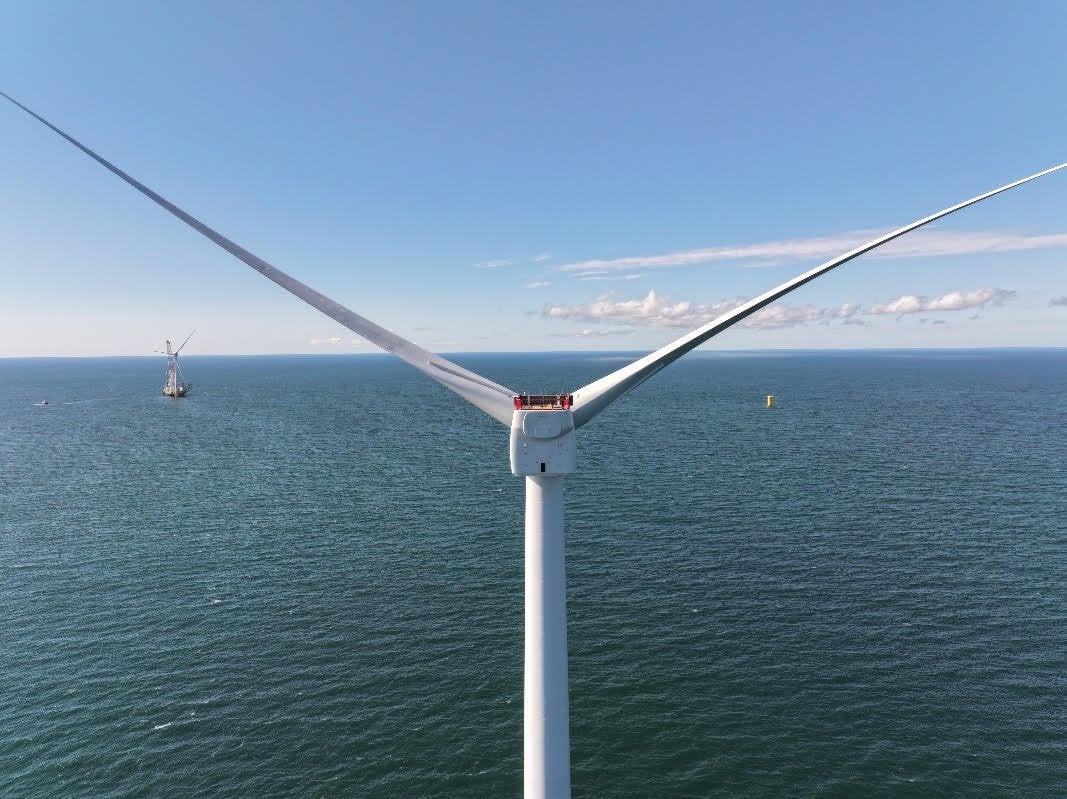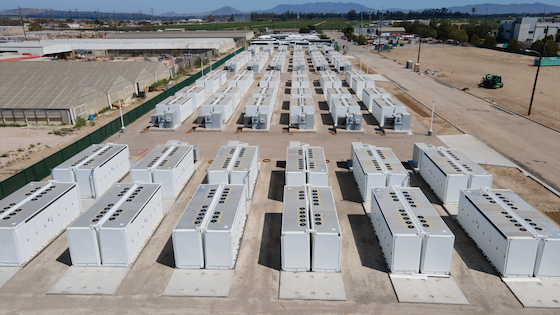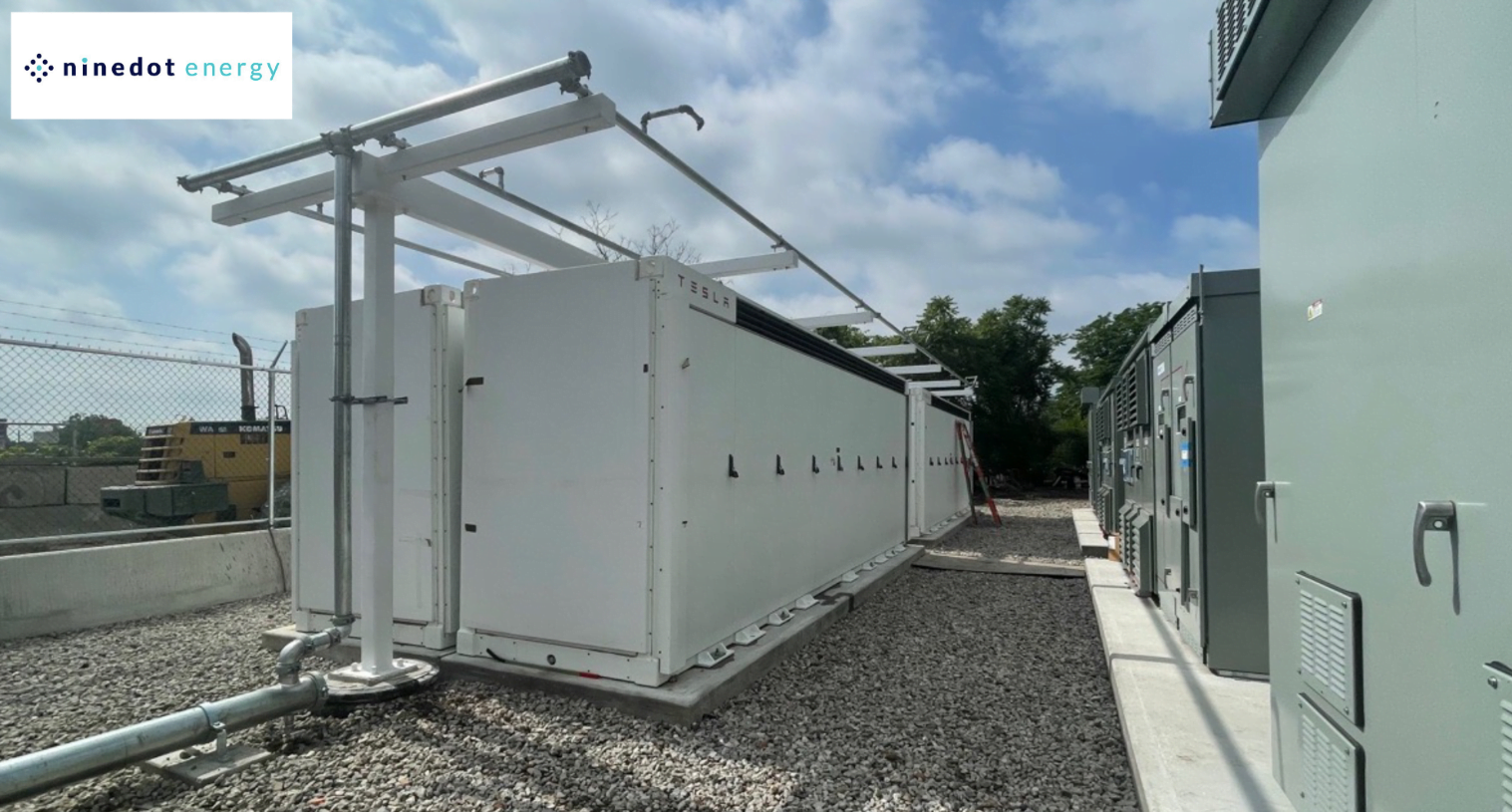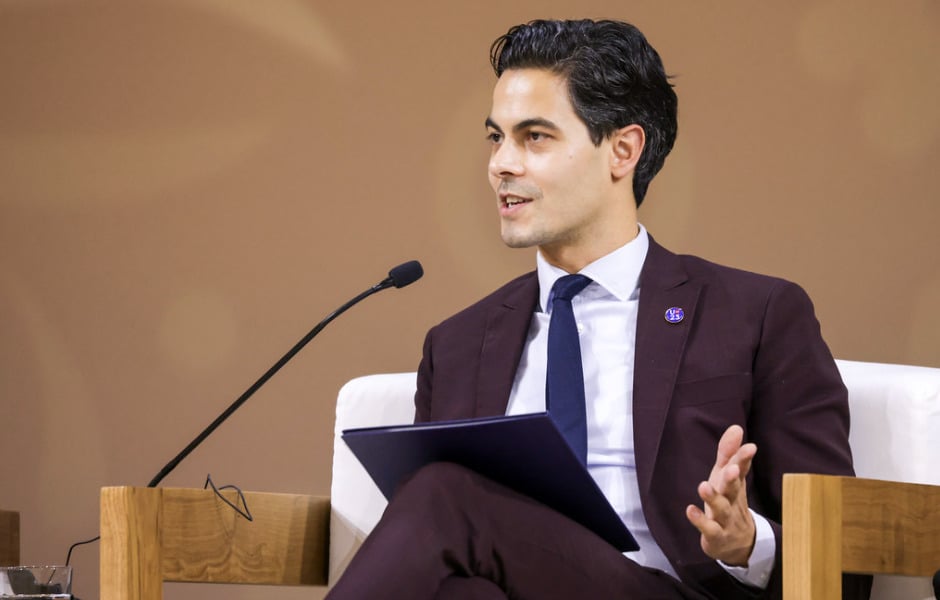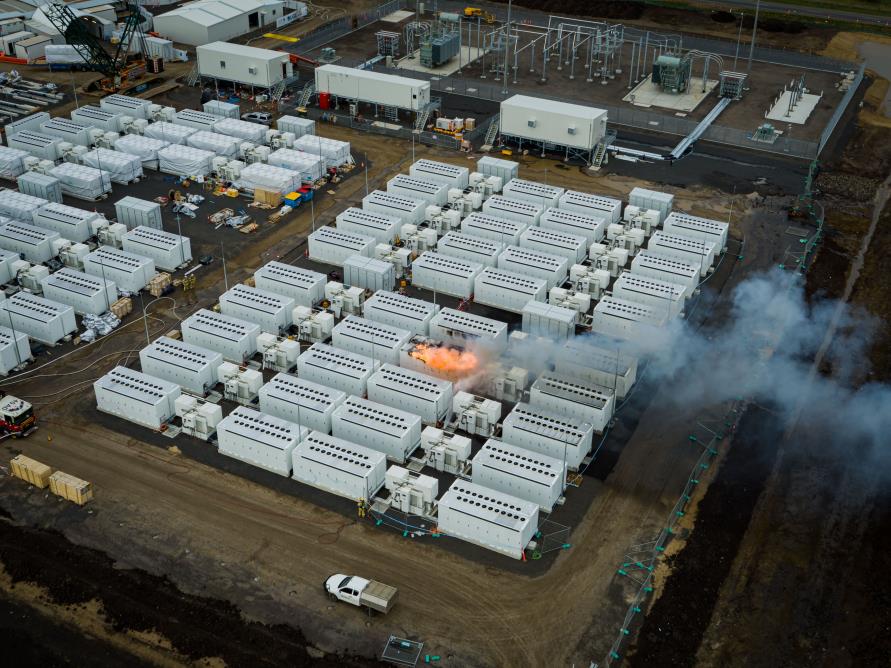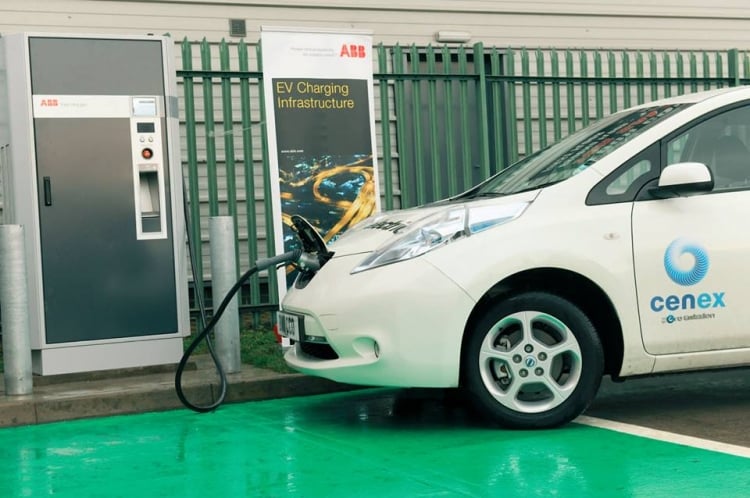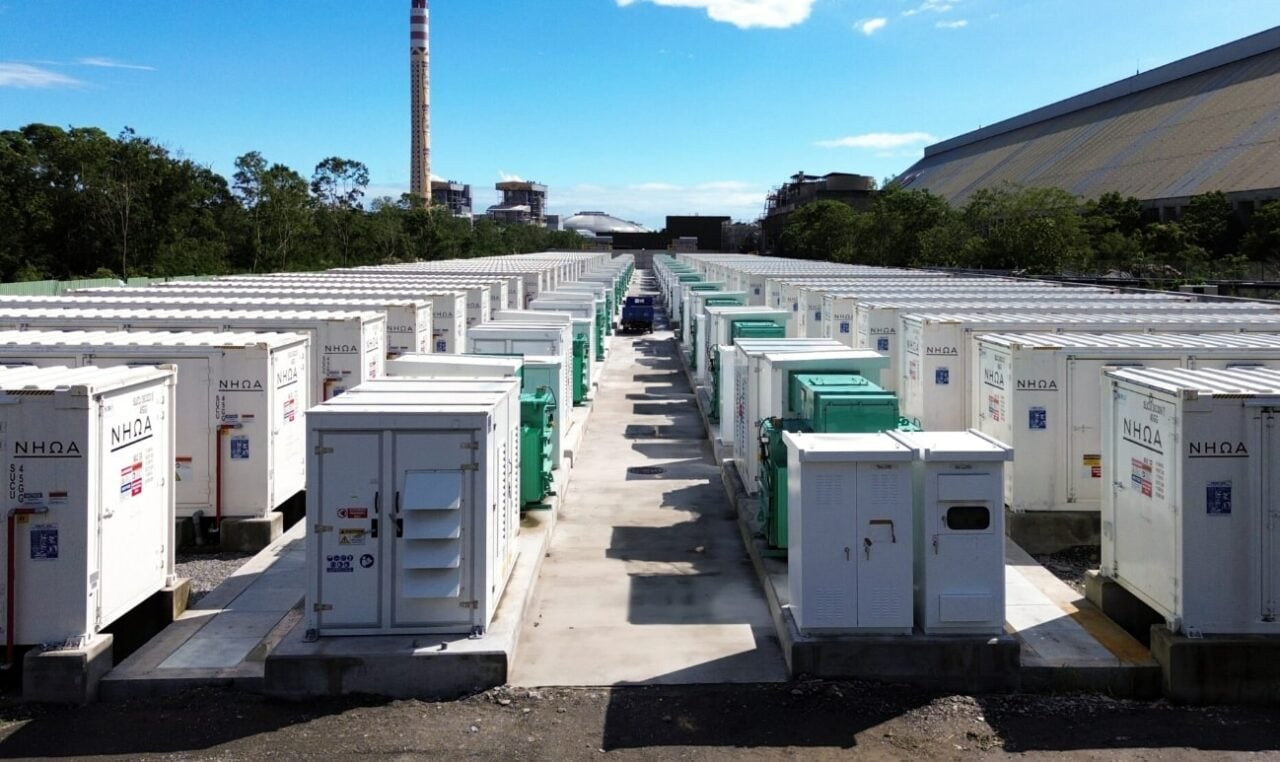Receivers for one of the Britishvolt companies, Bob Maxwell and Julian Pitts of Begbies Traynor Group, told outlet the Guardian that Blackstone planned to turn the site into “one of the largest data centre facilities in western Europe”.
A blow to domestic battery production
Britishvolt emerged in 2019 with an ambitious plan to build a car battery gigafactory to rival the Chinese-owned AESC plant in Sunderland. Promising to generate as many as 3,000 jobs, Britishvolt won tens of millions of pounds of private investment but failed to secure the orders necessary for further funding.
In January 2022, then-Prime Minister Boris Johnson hailed the startup’s plans, and Britishvolt became a flagship of his levelling up policy. The government promised a £100 million subsidy to the company.
By August of the same year, the Guardian reported that construction of the 30GWh factory had been put on ‘life support’. Britishvolt collapsed into administration in January 2023, a year before the first batteries were due to be produced.
It was then acquired by Australia-based Recharge Industries, owned by investor Scale Facilitation, the following month. Scale’s CEO David Collard told BBC News at the time that the company would pivot the gigafactory to selling to producing batteries for the energy storage system (ESS) market, something McKinsey battery expert Dr. Nicolo Campagnol told Energy-Storage.news has upsides and disadvantages to it (Premium access).
Former Britishvolt employee and communications advisor Ben Kilbey said on Linkedin in reaction to the Blackstone news: “At the end of the day, after the farce of an administration and the complete car crash that was the potential purchaser – we should be glad that the land, which was starting to resemble an elephants graveyard, will be put to some use.”
See the original version of this article on our sister site Current.
New England states apply for US government transmission and energy storage funding
The programme makes US$5 billion available to states between the 2022 and 2026 fiscal years and is aimed at supporting projects which enhance the reliability and resilience of the grid through technologies, including transmission upgrades, energy storage, and distribution grid upgrades, with an emphasis on innovation.
The coalition of New England states is applying with two projects: Power Up New England, which will upgrade and add new grid interconnection points between the southeastern parts of Massachusetts and Connecticut, and Clean Resilience Link, which would increase electricity transfer capacity between New England and New York.
It is understood that the states would seek the upper end of the US$250 to US$1 billion available to each project through the GIP, given they fall into the more expensive transmission category. The current second round of the programme, for which applications closed yesterday, will disburse up to US$1.82 billion.
While both projects will unlock increased ability to integrate renewable energy on the New England grid and opportunities for energy storage, Power Up New England is perhaps of more immediate interest to Energy-Storage.news readers in terms of directly including energy storage resources.
With the Atlantic coast of the US set to host multiple gigawatts of offshore wind generation in the coming years, the states claimed Power Up New England’s interstate link would enable the development of up to 4,800MW of new offshore wind and energy storage resources in Connecticut and Maine.
An announcement by the Connecticut Department of Energy and Environmental Protection noted that the Power Up England application is supported by energy storage developer Elevate Renewables, utilities and developers Eversource and National Grid, and an undisclosed “multi-day energy storage technology provider.”
Energy-Storage.news would take an educated guess that the technology provider is startup Form Energy, which is developing an iron oxide-based battery technology and building its first factory in West Virginia.
The site has contacted Form for confirmation and is waiting for a reply but given that the company authored a paper in Q3 last year on the value of multi-day energy storage in New England, it would not be surprising if it were so.
Meanwhile, developer Elevate Renewables’ business model is deploying large-scale standalone battery energy storage system (BESS) assets at the sites of existing or former thermal generation power plants.
At the beginning of this month the company, which is owned by independent power producer (IPP) Arclight, said it was “exploring or advancing” plans to deploy BESS assets on the sites of at least five power stations in Connecticut. Arclight committed US$150 million investment to its energy storage subsidiary in 2023 after forming Elevate Renewables a year prior, with a remit to develop and install utility-scale battery energy storage systems co-located with existing power infrastructure.
In related news, a new study was published last week (11 April) which identified that Maine’s fleet of fossil fuel peaker plants could be effectively replaced with batteries.
Authored by consultancy Strategen for the non-profit group Clean Energy States Alliance, the study found that the business case for batteries would largely be based on energy capacity market revenue opportunities, and that this model would be widely replicable throughout the New England region.
Arevon signs long-term offtake with non-profit utility MCE for 1GWh California BESS
A first phase of 188MW will begin construction in Q1 2025 and will become operational in 2026. Arevon didn’t reveal when the second phase of the project would come online.
Such long-term tolling agreements and power purchase agreements (PPAs) in California have helped make it the leading US state for BESS deployments, with 7.6GW online as of the end of March 2024, according to transmission system operator (TSO) CAISO. Such long-term agreements help project owners acquire financing from financial institutions that can be typically risk-averse, such as banks.
For example, Arevon recently secured a US$1.1 billion debt and tax equity package for a solar-plus-storage project, also in California, which has a long-term PPA agreement with a for-profit utility Southern California Edison (SCE). In November, the firm claimed to have completed “one of the first” investment tax credit (ITC) deals using new a transferability mechanism under the Inflation Reduction Act.
“Battery storage is critical to fast-tracking the clean energy transition. Through our partnership with Arevon, we are bringing online our largest battery storage project yet to support clean, reliable, and affordable electricity service for the Bay Area residents and businesses we serve,” Dawn Weisz, MCE CEO said.
New York community-scale developer Ninedot secures US$13 million real estate financing
The company launched its range of capital solutions for battery storage developers in January this year, offering land purchases, lease purchases and land loans for projects.
SolaREIT, founded in 2020 by self-proclaimed clean energy industry veterans, aims to streamline the process of acquiring suitable land for solar and storage projects, which can be capital and land-intensive. According to the company, around 15% of a project’s total cost goes on land.
Ninedot CEO and co-founder David Arfin said the REIT “tailored a product that supported our purchase of some sites for our battery storage projects,” based on an understanding of the developer’s needs.
Ninedot is developing between 30 and 40 battery energy storage system (BESS) projects in the New York Metropolitan areas of New York City, Westchester County and Long Island, each planned with 5MW output and 20MWh capacity (4-hour duration).
As defined by research and analysis group Wood Mackenzie, community-scale energy storage is a solar-paired or standalone storage facility “brought online within a specific community-scale generation programme.”
Within New York, that means the state’s Value of Distributed Energy Resources (VDER) scheme, sometimes also referred to as the Value Stack. Under VDER, distributed energy resources such as solar PV and storage are compensated based on a set of key metrics relating to the value they provide.
That value is defined in terms of energy, capacity, environmental, demand reduction and locational system relief. Administered by the state’s regulatory Public Service Commission, compensation is paid out in the form of bill credits.
Customers can then subscribe to the community programme; for example, Ninedot counts coffee chain Starbucks among its subscribers.
In an interview with Energy-Storage.news earlier this year, Joe Silver, senior product manager at Ninedot, said that there are “three key parts of the Value Stack that are really beneficial to storage,” these being demand reduction, capacity, and locational relief.
In addition, Ninedot also monetises its BESS assets through enrolment in demand response programmes.
Silver—who was speaking to the site in January about Ninedot’s involvement in a vehicle-to-grid (V2G) pilot project which also enrolled in VDER—noted that the programme is unique, and while that makes it a standout opportunity for developers, is also a challenge to scale, because there aren’t similar programmes in other states to compare it to or learn from.
Nonetheless, he said, VDER is “very smart and provides a lot of signals that developers like ourselves can take advantage of and use to provide a lot of value to the grid, and customers.”
Also in January, Ninedot secured US$225 million in financing through equity capital commitments led by insurer Manulife, bringing the developer’s total money raised to date to more than US$400 million. SolaREIT meanwhile raised US$250 million in September last year, together with investment management group AB CarVal.
With New York targeting 6GW of energy storage deployments by 2030 under the state Climate Leadership and Community Protection Act (CLPA) policy, a significant portion is likely to have to come from distributed resources in a state with limited land and densely populated urban areas.
Outgoing Dutch government allocates €100 million in accelerated subsidies for solar-plus-storage in 2025
It is one of the current government’s last moves, after elections for the House of Representatives in June last year saw the right-wing anti-immigration PPV become the largest party in the House, with a coalition still being formulated.
The €100 million (US$106 million) allocation is part of a €416 million package for PV co-located battery energy storage system (BESS) technology that was initially to total €41.6 million a year, starting in 2025, for ten years. The 2025 programme is set to open on 1 January 2025, and more details will be released to the House later this year.
The move by Jetten sees its first year’s total more than double, and the government has also reserved €200 million for the following year, meaning a deployment of the funds in the first two two years over seven times’ quicker than initially planned. The €200 million will be adjusted based on the learnings from the initial €100 million.
Operating subsidy of €0.14-29 per kWh
The funds will provide an operating subsidy to projects for each kWh of energy they discharge into the electricity market during peak demand hours when there is typically a shortage of renewable energy generation.
The initial estimate for the subsidy is €0.14-29 per kWh of energy discharged. Independent research and consultancy organisation CE Delft has been heavily involved in the analysis of the scheme until now.
The scheme is open to all sizes of technologies, including BESS co-located with rooftop solar PV as well as grid-scale plants and ‘batteries of different sizes are allowed to participate’. However, an explanation of the scheme from the government includes some relatively strict criteria.
A big one is that the combined installation of solar PV and BESS may not supply electricity between 9 am and 5 pm from May to September, instead reserving those hours to charge the BESS with solar for discharging to the grid between 5 pm and 9 am. The BESS can also participate in other electricity market avenues during those off-peak hours.
The government has also indicated that the BESS will need to obtain at least 75% of its energy from the co-located generation. That compares to the effective 100% requirement that solar-plus-storage projects used to need in order to qualify for an investment tax credit (ITC) in the US, and still do for Germany’s Innovation Tender.
The subsidy is needed because BESS co-located with PV are ‘not profitable’, the government said. It expects the €100 million to be able to support the deployment of 160-330MW of BESS.
Building a business case for BESS in the Netherlands has been a major challenge for the industry, as detailed in interviews with developer-operator SemperPower (Premium access) and developer Lion Storage, with SemperPower saying that virtually no new grid-scale BESS would come online in 2024.
Without subsidies, transmission system operator TenneT expects about 2GW of BESS to be online in the Netherlands by 2030, much lower than the 9GW it forecasts it needs.
See Jetten’s letter announcing the accelerated deployment of the funds (in Dutch) here.
Safety practices of the BESS industry, Part 2: Battery analytics
As we have seen in numerous territories in the US and UK in particular, battery energy storage system (BESS) is sometimes perceived by local communities as a potential fire and even explosion hazard.
In this series, we will look at some of the things that companies in the industries are doing to mitigate fire and explosion risk.
In the previous instalment, we focused on BESS product design and spoke with Helena Li, executive president at Trina Solar, about the safety features built in to the design of Elementa 2, the newest BESS solution from the vertically integrated solar PV company’s Trina Storage subsidiary.
This time out, we speak with Kai-Philipp Kairies, CEO of ACCURE, a cloud-based battery analytics solution provider.
Although our discussion took place earlier this year at the Energy Storage Summit EU in February, and some of you will have already read our feature interview from that conversation, publication of the following previously unpublished excerpts is timely.
Just this week, another town planning board in the US state of New York, Oyster Bay on Long Island, declared a six-month moratorium on BESS development. This has been the case for a few other local authorities having jurisdiction (AHJs) in New York, while the state wrestles with the aftermath of fires that took place last year at battery storage sites.
Thankfully, no casualties were reported from those fires, and an interagency working group convened by the state’s governor, Kathy Hochul, to investigate and ensure no future incidents can happen, found no lasting damage to human health. However, it’s fair to say reputational damage was done.
At the same time, New York has struggled, like other urban centres worldwide, with the much more serious problem of cheap, poorly made micromobility devices such as e-scooters and e-bikes presenting a serious fire hazard. Again, the protections, regulations, and technologies in and around BESS assets are several steps above what is included in micromobility battery systems, but in terms of public perception, the impact is still harmful to the reputation of batteries in general.
Kairies gives us one example of what he says are many, where his company’s analytics solution was able to step in and solve a potential safety problem and at the same time give reassurances to the local community.
Battery analytics has been explored from several angles on this site, including a series of deep dive webinars with providers TWAICE and PowerUp.
ACCURE’s Kai-Philipp Kairies and a team from rival/frenemy company TWAICE were even persuaded to publish back-to-back articles in Volume 35 of our quarterly journal, PV Tech Power, published last summer.
Dr Stephan Rohr, Sebastian Becker and Dr Matthias Simolka from TWAICE covered the role of analytics in de-risking BESS deployment, while ACCURE’s Kairies took a technical deep dive into analytics and their role in commissioning.
ACCURE was contracted to help at the commissioning phase of a large-scale solar-plus-storage project by National Grid Renewables, the US-based clean energy developer arm of National Grid, operator of the UK’s electricity network.
The project, a 275MWac solar facility with 125MWh BESS in Texas, was delayed on commissioning, and Kai-Philipp Kairies says the support ACCURE was able to provide brought the timeline of the delay down from the two or three months the developer was expecting to face, to a couple of weeks.
“They were very positively surprised by how much we could help,” Kairies says, with National Grid Renewables then contracting the analytics provider to continuously monitor its entire fleet of BESS assets.
Analytics during the commissioning phase can be used to troubleshoot and fault-find things like cell imbalances, improperly installed modules, battery management system (BMS) failures, and others that, Kairies claims, without the software can be like finding a needle in a haystack.
Then there’s what analytics can do on safety. ACCURE claims to have prevented dozens of potential fires for its clients. However, prevented fires don’t tend to make news headlines.
There are dozens of examples of members of local communities around the world being opposed to battery storage systems in their areas. Some of these are around concerns such as visual impact, or industrialisation of greenfield sites, or even—in a growing number of cases—noise from asset operation.
Yet by far, the most common reason cited, at least as far as the pages of anecdotal evidence gathered by this writer to date, is around safety, namely fire safety and explosion risk.
Of course, battery storage asset owners and investors have a vested interest in not seeing their asset go up in flames, but as our interview a while back with battery fire safety expert and former firefighter Paul Rogers at Energy Safety Response Group showed, BESS integrators very often underestimate the depth of feeling among the public and AHJs on this subject.
Real-world data is best proof of safety
One of the reasons National Grid Renewables worked with ACCURE is to be able to show communities the work that it does to ensure safety of its solar PV and energy storage sites, Kai-Philipp Kairies says.
“In the US, there’s been too many battery fires. Let’s just face it, there’s some battery systems that had fires two times in a year,” Kairies says.
Some among the Texas community near the solar-plus-storage site in question had even started a petition: “not even a moratorium [on new development] but to tear it [the project] down,” Kairies says.
“Obviously, that’s problematic. I think we need to take the concerns very seriously, and as an industry, it’s our job to deliver safe systems. So National Grid Renewables said, ‘Hey, we want to do everything we can. So we’re using ACCURE’s Safety Manager to prevent such events’.”
National Grid Renewables “actively promotes” those safety features to the community, Kairies, says, which “seems to resonate well” with the public.
“We can show here that we’ve got his track record of finding stuff before it happens. It’s rare, but if it happens, we’ll find it, and that really just shows the communities that they’re being heard.”
Resources for ESN Premium subscribers:
Using battery analytics to support BESS commissioning: A technical deep dive
Published in PV Tech Power Volume 35
Cloud-based analytics for de-risking BESS deployment and operation
Published in PV Tech Power Volume 35
VIDEO: De-risk and protect your battery assets with digital commissioning and in-life analytics
Sponsored webinar with TWAICE
VIDEO: The economic benefits of cloud-based battery analytics for battery storage assets
Sponsored webinar with PowerUp
Startup Green Li-ion launches North America’s ‘first’ black mass-to-pCAM battery recycling plant
That capacity is relatively low but the company’s strategy is to set up many of its low-capex units, which use a novel and advanced hydrometallurgical approacy, in existing recycling facilities with an installation time of just a few months.
This allows the facility to convert its black mass from shredding battery material directly into pCAM in a process that takes 12 hours, emits up to 90% fewer greenhouse gas (GHG) emissions than virgin materials processing and can achieve 99% purity, the firm claims.
Facilities could then sell that pCAM to CAM or battery manufacturing facilities. pCAM is a mixed-metal hydroxide made up of various critical metals like nickel and cobalt, to which lithium hydroxide is added to create cathode active material (CAM) which can then be used to build batteries.
The US’ Inflation Reduction Act has generous tax credit incentives for battery cell and module manufacturing but there are challenges around building up a local supply chain for the critical metals needed, like cobalt, nickel and lithium. Green Li-ion is also targeting installations of its technology directly in battery gigafactories.
The Department of Energy (DOE) has put put big funds into the recycling sector in the US, with federal loans of US$2 billion to Redwood Materials and US$375 million to Li-Cycle in 2023.
But the end of the year saw Li-Cycle’s future thrown into doubt after it revealed forecasted construction costs for its main recycling facility had nearly doubled, leading to a US$95 million write-down and a process to seek ‘strategic alternatives’ (Premium access).
Leon Farrant, CEO and co-founder of Green Li-ion commented: “Electrification will require manufacturers to exert greater control over their critical mineral supplies. We aim to show American companies the benefits of a customisable and fully vertically integrated battery recycling solution when operating as part of an existing manufacturing process.”
Energy-Storage.news’ publisher Solar Media will host the 2nd Energy Storage Summit Asia, 9-10 July 2024 in Singapore. The event will help give clarity on this nascent, yet quickly growing market, bringing together a community of credible independent generators, policymakers, banks, funds, off-takers and technology providers. For more information, go to the website.
AI-driven optimiser GridBeyond raises €52 million from investors including ABB, Energy Impact Partners
GridBeyond uses its artificial intelligence (AI) software to optimise the participation of distributed and front-of-the-meter (FTM) energy assets, including commercial and industrial (C&I) energy storage and demand response, grid-scale storage, and other technologies, in available market opportunities.
That means accessing wholesale markets for day-ahead, intraday, imbalance, frequency regulation and any local distribution system operator (DSO) markets, said CEO Michael Phelan, who spoke with Energy-Storage.news earlier today.
At the same time, for customers that want to maximise their involvement in the energy transition away from fossil fuels through corporate renewable energy power purchase agreements (PPAs) with 24/7 power matching, the GridBeyond platform is used to capture surplus solar or wind power, store it in the battery and then use it at the best time from an economic perspective.
In other words, any clean energy asset that can be optimised for revenue and carbon footprint can be connected to the platform, which the company has been developing since 2010. GridBeyond has more than 2,600MW of assets under management, including more than 500MW of battery storage.
“Using software with human oversight” is the company’s approach, Phelan said.
“A lot of trading to date has been done by humans, with a small amount of software input. We’re almost coming at it from the other side.”
While the human-led approach can work for very large assets, such as grid-scale standalone battery energy storage systems (BESS), GridBeyond realised that, especially when it comes to smaller, distributed assets, “it’s not possible to have a human on every asset.”
“We’ve kind of turned it on its head a little bit and said, ‘If we’re trading lots and lots of small batteries, we’re trading lots and lots of small systems, eventually EVs and various [other] things, we need to be able to turn them into useful blocks of power that can be traded by software, with human oversight and maybe the software acting as a fairly strong co-pilot in terms of making all those trades,” the CEO told Energy-Storage.news.
‘Robotic co-pilot’ for trading energy from distributed assets
A significant portion of the funds raised will be “targeted at the use of AI for energy storage, energy flexibility and the energy transition,” while the rest will help further GridBeyond’s international expansion.
The company is present in markets in the UK and Ireland, where Phelan claimed it is perhaps the biggest aggregator of distributed-scale storage systems below the 50MW mark, and ramped up its push into deregulated US energy markets, such as ERCOT in Texas, during 2023.
The financing, which was led by Klima, the energy transition fund of financial services group Alantra, will help further enhance GridBeyond’s product, described as a Grid Edge Virtual Power Plant solution, so that it can be adapted for all opportunities in the markets it operates in.
“From a technology point of view, we’re continuing to develop the platform so that we can handle, in a co-pilot, almost robotic way, all assets that are available to us.”
As well as furthering its position in the UK, Ireland, and ramping up in US deregulated and even some regulated markets, Australia and Japan are also target markets, Phelan said.
ABB’s minority investment is a strategic one, the automation company said in a release of its own today, that will enable its customers to optimise their distributed energy resources and industrial loads through GridBeyond’s AI and data science-backed energy management solutions.
“They’re kind of adding AI and software to their market-leading hardware. So, they’re one of the leading suppliers of EV charging systems and very strong battery offerings, and they feel that the AI and systems that we have adds a lot of value to those systems,” Phelan said.
“If we work together, then it’s kind of a win-win for everybody.”
Several others among the investors GridBeyond has brought on board in the new round have similarly complementary offerings, albeit in different ways and in different geographies: from Constellation, which is a US utility based in Maryland, electrical engineering and software company Yokogawa Electric in Japan and Energy Impact Partners, which is a venture capital (VC) firm well known in the clean energy space for its investments in everything from EV infrastructure providers to long-duration energy storage (LDES).
Earlier this year, GridBeyond asset development director Scott Berrie took the lead in a sponsored webinar with Energy-Storage.news, looking at the growing appetite for merchant risk in the front-of-the-meter battery storage space, joined by representatives of UK developers Zenobe Energy and Fig Power.
This followed a feature article contributed to our quarterly journal PV Tech Power Vol.36 (Q3 2023) from the company’s US-based team, which looked at the optimisation of battery storage assets in that country’s two leading markets, ERCOT and CAISO.
Mitsubishi Power’s BESS spinout and ownership restructure to make unit more ‘nimble and fast-moving’
Energy storage business needs to ‘stand on its own’ to compete
The ownership restructure was revealed in Prevalon’s announcement of a supply deal with battery OEM Rept last week, which described ‘Prevalon as a Mitsubishi Power Americas and EES joint venture’, having called it a ‘wholly-owned subsidiary of Mitsubishi Power Americas’ when the spinout was announced.
The separation of the energy storage activities into a standalone company outside of Mitsubishi Power Americas was about helping it to keep up with the market, as Cornell explained.
“In 2018, we chose three energy transition businesses to focus on – battery storage, solar development and hydrogen, and the plan was to launch, grow them and explore avenues to make them successful, which could be keeping it within Mitsubishi Power, spinning it out or even divesting it,” he said.
“We decided to rebrand the energy storage activities into Prevalon and stand it up on its own, based on its high growth rate, how quickly it needs to move and who it is competing with. The thought was to make it as nimble and fast-moving as possible to help the business.
“We’ve set up a new board with new governance and streamlined a lot of things. It will operate with a low overhead structure but still the backing of Mitsubishi Power.”
Cornell was keen to emphasise that Mitsubishi Power Americas is still heavily involved in the business and that private equity is not involved in the new ownership restructure, a type of investor with some downsides.
Cornell: “We’re not going to be chasing market share for the sake of market share. Once private equity steps in, they have high demands to grow the business and may start seeking to win projects at thin or negative margins. We want to chase projects that are viable, with customers that will value the lifecycle of the project and where we can really add value.”
“The way we’ve capitalised the business means we’re in great shape. We want to grow at a controlled rate with a five year horizon to take Prevalon to be a US$1 billion business.”
Prevalon’s strategy going forward
With a new ownership structure and increased independence from Mitsubishi Power Americas, Cornell discussed Prevalon’s technology and market approach going forward.
“We have about a dozen customers with very large portfolios, and will basically be working with them in their different markets, rather than going into new markets blind,” Cornell said.
The company is executing on large-scale BESS projects in California, Idaho, Oregon, Mississippi, and the Southeast US (states undisclosed), as well as in Chile. Projects have generally moved from mostly being solar-plus-storage a few years ago to now mainly being standalone, while duration is moving beyond 4-6 hours too.
“We expect there will be more emerging energy storage markets in the Southeastern US with the benefits of direct pay for co-ops,” Cornell said, alluding to the ability of non-tax paying entities like electric co-operative utilities to monetise the Inflation Reduction Act’s tax credits by receiving direct payments from the Federal government.
On the technology side, the company has transitioned from its ‘Emerald’ platform to its new ‘High-Density (HD) 511 Integrated Energy Storage Platform’ for which it has partnered with battery OEM Rept. Cornell explained what that meant in separate comments included in our coverage of that announcement yesterday.
Mitsubishi Power is the power solutions arm of Mitsubishi Heavy Industries (MHI), one of the four companies making up the Japanese conglomerate founded in 1870. MHI has annual revenues of around US$30 billion.
NHOA commissions 120MWh BESS in Taiwan
The company said its projects in Taiwan provide both ancillary services like E-dReg (Enhanced Dynamic Regulation) as well as behind-the-meter peak shaving services.
It follows its commissioning of a 311MWh system in December, the largest in Taiwan, which was specifically designed for E-dReg as the firm said at the time. That was also for an industrial site of parent company TCC, which acquired a majority stake in NHOA from Italy utility Engie in 2021, with NHOA called Engie EPS prior to that.
TCC’s chairman Nelson Chang said in 2022 that Taiwan will need 90GW of energy storage by 2030 to integrate new renewable energy capacity. Other energy storage technology providers Fluence and Invinity are also active there.
The SuAo announcements just a few days after NHOA’s EV infrastructure division was awarded a grant by the European Union under the ‘CEF Transport – Alternative Fuels Infrastructure Facility (“AFIF”)’ programme, receiving €17.2 million (US$20 million) to deploy 700 chargepoints in Italy.
Each charging station will either come equipped with on-site BESS technology or be readily adaptable for it which would allow them to efficiently manage and optimise peak charging, the company said.
The energy storage division of NHOA accounts for the bulk of revenues and it grew the segment 33% last year despite a 20% drop in industry-wide prices for BESS, the firm said in February. It has 2GWh of BESS capacity either operational or under construction globally.
Energy-Storage.news’ publisher Solar Media will host the 2nd Energy Storage Summit Asia, 9-10 July 2024 in Singapore. The event will help give clarity on this nascent, yet quickly growing market, bringing together a community of credible independent generators, policymakers, banks, funds, off-takers and technology providers. For more information, go to the website.



